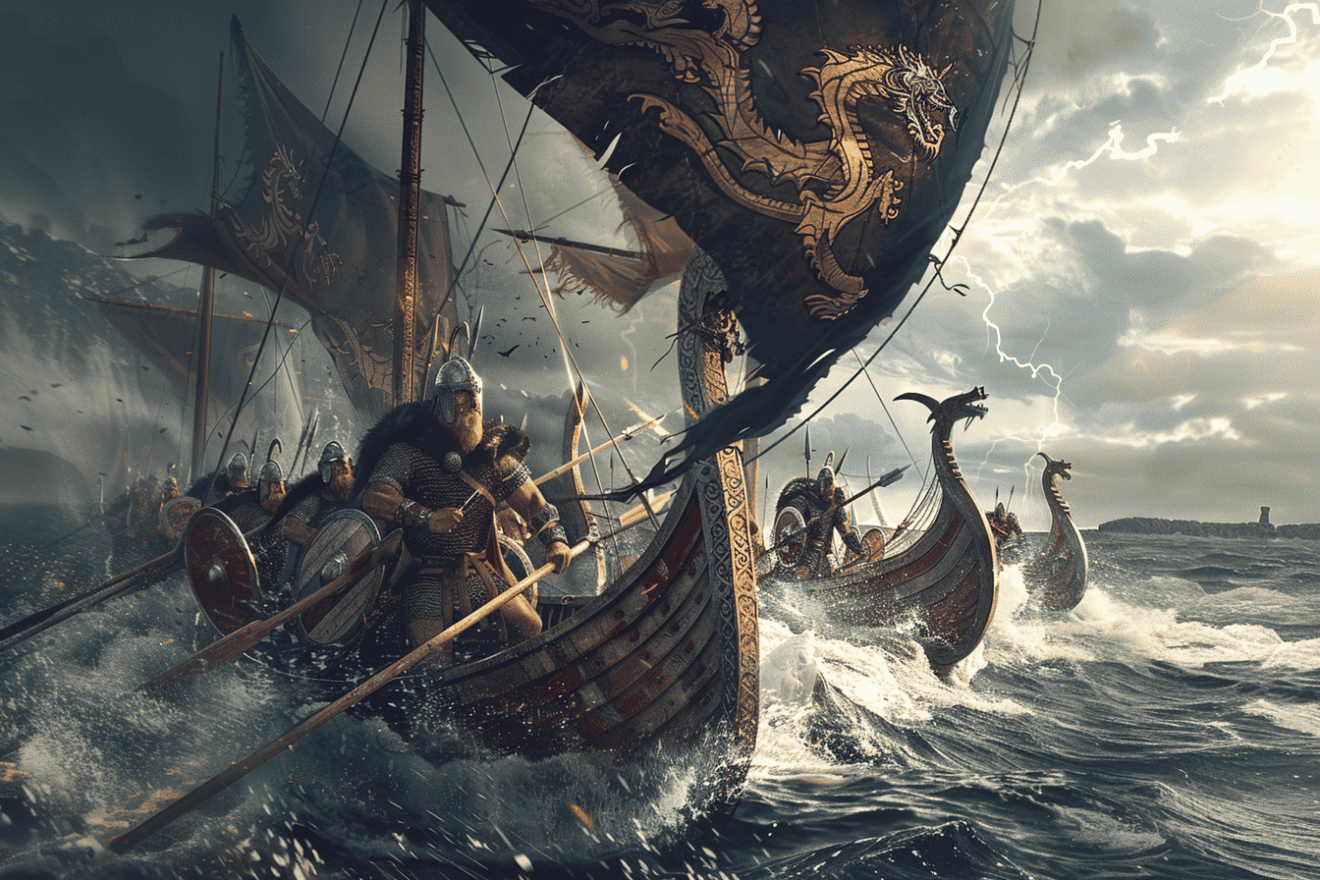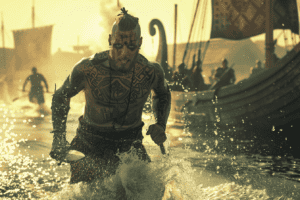The Viking Battle of Svolder, fought in the year 1000 CE, remains a pivotal and intriguing chapter in the annals of Viking Age history.
This brutal naval clash, sparked by the treacherous alliance of Danish King Sweyn Forkbeard and Swedish King Olaf, saw the Norwegian fleet catastrophically defeated, culminating in the tragic downfall of King Olaf Tryggvesson.
As the Baltic Sea ran red with the blood of the vanquished, a new power dynamic began to take shape. But what led to this fateful convergence of rival forces, and what would be the long-term consequences of this bloody struggle?
The Battle of Svolder Unfolds

In the midst of a treacherous alliance, the Danish King Sweyn Forkbeard, Norway’s Earl Erik, and the Swedish King Olaf, converged on the Baltic Sea, their warships poised for battle. The year was 1000 CE, and the stage was set for the infamous Battle of Svolder.
According to the medieval Icelandic Sagas, the three leaders had formed an alliance to crush their common enemy, Norway’s King Olaf Tryggvesson. However, their intentions were far from noble, and each leader had their own agenda. Sweyn and Erik sought to expand their territories, while Olaf hoped to gain an advantage over his rival.
As the battle commenced, the warships clashed, and the Vikings engaged in fierce combat. The Swedish and Danish forces, backed by their superior numbers, slowly gained the upper hand. King Olaf’s ships, despite their bravery, began to falter. The Norwegian king’s fate was sealed, and his warships were surrounded by the enemy.
The Battle of Svolder was a turning point in the history of Scandinavia, shaping the course of Viking Age politics and power struggles.
The Fate of King Olaf

King Olaf’s warships, now surrounded by the enemy, faced imminent destruction as Swedish and Danish forces closed in for the kill. The Norwegian king’s fleet was vastly outnumbered, and it seemed only a matter of time before they’d be overwhelmed.
Despite the dire situation, Olaf refused to surrender, opting to fight to the end. According to the Norse sagas, the king stood tall on the deck of his flagship, the Long Serpent, rallying his troops for a final stand.
As the battle raged on, Olaf’s warriors fought valiantly, but they were no match for the superior forces arrayed against them. One by one, the Norwegian ships fell to the enemy, until only the Long Serpent remained. Surrounded by the Swedish and Danish vessels, Olaf’s fate was all but sealed.
In the end, it wasn’t the enemy that claimed the king’s life, but rather his own hand. According to legend, Olaf leapt into the sea, choosing to drown rather than face capture and humiliation. The once-mighty king of Norway had fallen, his reign brought to a close by the defeat at Svolder.
Betrayal on the Baltic Sea

The treacherous alliance of Swedish and Danish forces, forged by deceit and broken oaths, had set its sights on the Norwegian fleet. This unscrupulous partnership, led by King Svein of Denmark and King Olaf of Sweden, sought to exploit the vulnerability of Norway’s naval forces.
As the Norwegian fleet navigated the treacherous waters of the Baltic Sea, the Swedish and Danish forces lay in wait, their ships concealed behind a seemingly innocuous island.
The Norwegians, unwary of the trap, sailed into the ambush, their vessels clustered together in a tight formation. The Swedish and Danish forces seized the opportunity, launching a surprise attack that caught the Norwegians off guard. The ensuing battle was fierce, with the Norwegian ships struggling to hold their ground against the superior numbers of their enemies.
As the fight raged on, the Norwegian fleet began to falter, its ships battered and bruised by the relentless onslaught. The fate of King Olaf’s reign hung precariously in the balance, as the Norwegian monarch fought to preserve his kingdom against the treacherous alliance that threatened to destroy it.
The Rise of Norwegian Power

Olaf’s eventual defeat at Svolder, however, ignited a Norwegian resurgence that would soon propel the country to unprecedented heights of power. In the aftermath of the battle, the Norwegian nobles and chieftains rallied behind Olaf’s successor, Sweyn Forkbeard’s son, Canute. Canute’s strategic alliances and military prowess soon paid off, as he conquered England and unified it under Norwegian rule. This marked the beginning of a golden era for Norway, characterized by economic prosperity, cultural flourishing, and territorial expansion.
As Norway’s power grew, so did its influence in the region. The country became a major player in European politics, with its monarchs forging alliances with other powerful nations. Norway’s navy, which had played a vital role in the Battle of Svolder, continued to expand, protecting the country’s interests and facilitating trade.
The Norwegian kingdom’s progress was further bolstered by the establishment of a strong, centralized government, which allowed for efficient administration and decision-making. As the years passed, Norway’s rise to prominence became a tribute to its people’s resilience and determination.
The Aftermath of Defeat

Defeat at Svolder sparked a crisis of confidence among the Norwegian people, with many questioning their leader’s ability to protect them from foreign threats. The loss of their naval fleet and the subsequent Danish occupation of Viken, a strategic region in southeastern Norway, further eroded trust in King Olaf’s rule.
As a result, many chieftains and nobles began to defect to the Danish side, seeking stronger leadership and protection. The Danish monarch, Sweyn Forkbeard, capitalized on this momentum, offering favorable terms to Norwegian rebels who surrendered to him. Meanwhile, Olaf’s remaining supporters were forced to flee or go into hiding, as the Danish army continued to assert its control over Norway.
The aftermath of Svolder also saw significant changes to Norway’s internal power structure. The once-unified kingdom was now fragmented, with various regions pledging allegiance to different leaders. King Olaf’s authority was severely weakened, paving the way for a new era of Danish dominance over Norway.
As the years passed, Norway’s identity as a distinct nation began to fade, replaced by a growing sense of Danish-Norwegian identity.










Add Comment